Anonymity Effects on Social Groups: SIDE Model and Literature Review
VerifiedAdded on 2020/12/26
|12
|2659
|165
Report
AI Summary
This report delves into the effects of anonymity on social groups, utilizing the Social Identity Model of De-individuation Effects (SIDE) to understand the impact on group behavior. The research employs content analysis of secondary data from journals and articles to gather quantitative insights. It examines the SIDE model's application to anonymity, considers McLeod's framework, and reviews contemporary studies on anonymity manipulations. The report analyzes the effects of anonymity on group dynamics, including social facilitation, decision-making, and relationship building, with a focus on the virtual world and computer-mediated communication. Findings are presented and discussed, including implications for understanding how anonymity influences individual and group behavior in various settings. The report highlights the importance of understanding anonymity's effects on group behavior in the context of social psychology.
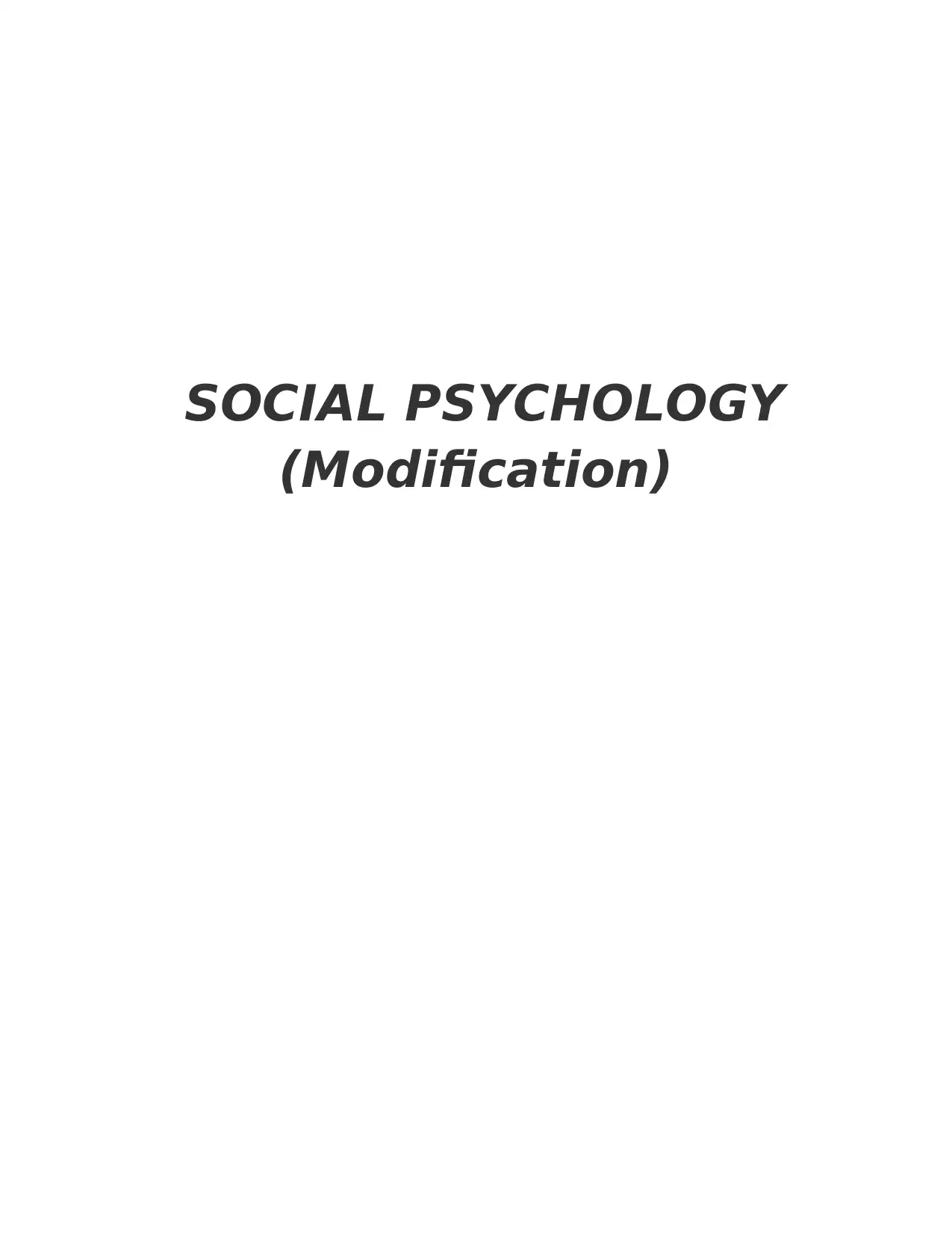
SOCIAL PSYCHOLOGY
(Modification)
(Modification)
Paraphrase This Document
Need a fresh take? Get an instant paraphrase of this document with our AI Paraphraser
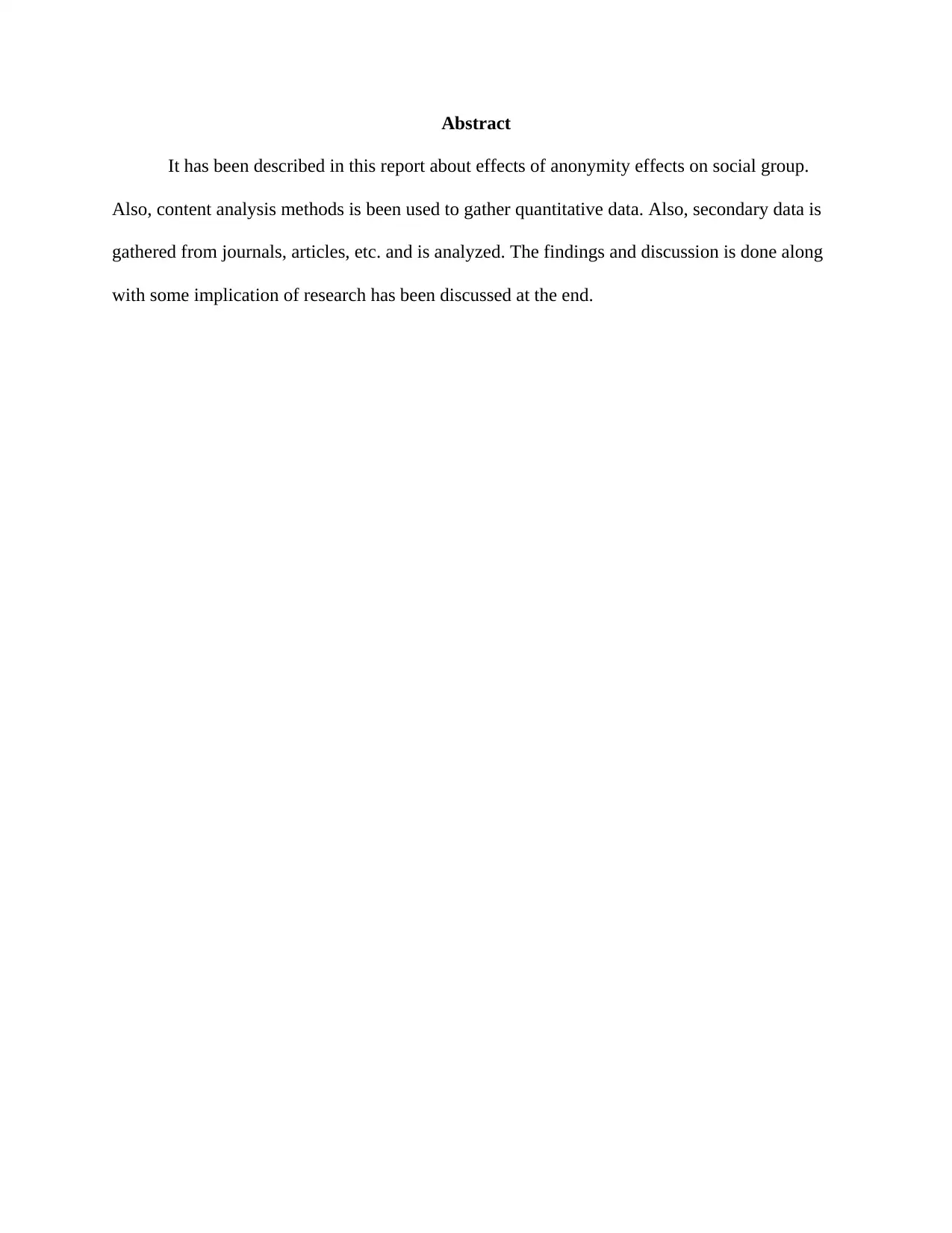
Abstract
It has been described in this report about effects of anonymity effects on social group.
Also, content analysis methods is been used to gather quantitative data. Also, secondary data is
gathered from journals, articles, etc. and is analyzed. The findings and discussion is done along
with some implication of research has been discussed at the end.
It has been described in this report about effects of anonymity effects on social group.
Also, content analysis methods is been used to gather quantitative data. Also, secondary data is
gathered from journals, articles, etc. and is analyzed. The findings and discussion is done along
with some implication of research has been discussed at the end.
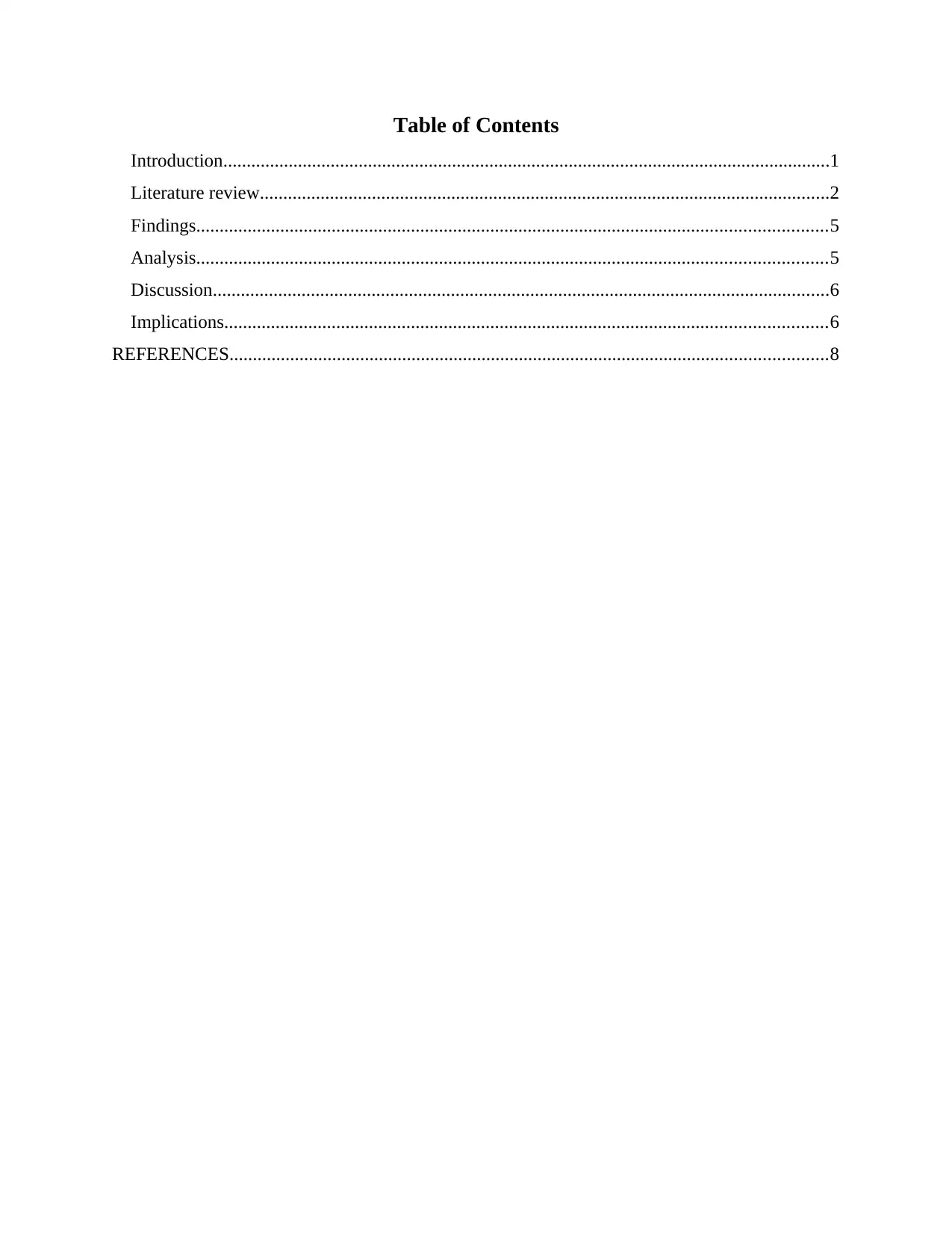
Table of Contents
Introduction..................................................................................................................................1
Literature review..........................................................................................................................2
Findings.......................................................................................................................................5
Analysis.......................................................................................................................................5
Discussion....................................................................................................................................6
Implications.................................................................................................................................6
REFERENCES................................................................................................................................8
Introduction..................................................................................................................................1
Literature review..........................................................................................................................2
Findings.......................................................................................................................................5
Analysis.......................................................................................................................................5
Discussion....................................................................................................................................6
Implications.................................................................................................................................6
REFERENCES................................................................................................................................8
⊘ This is a preview!⊘
Do you want full access?
Subscribe today to unlock all pages.

Trusted by 1+ million students worldwide
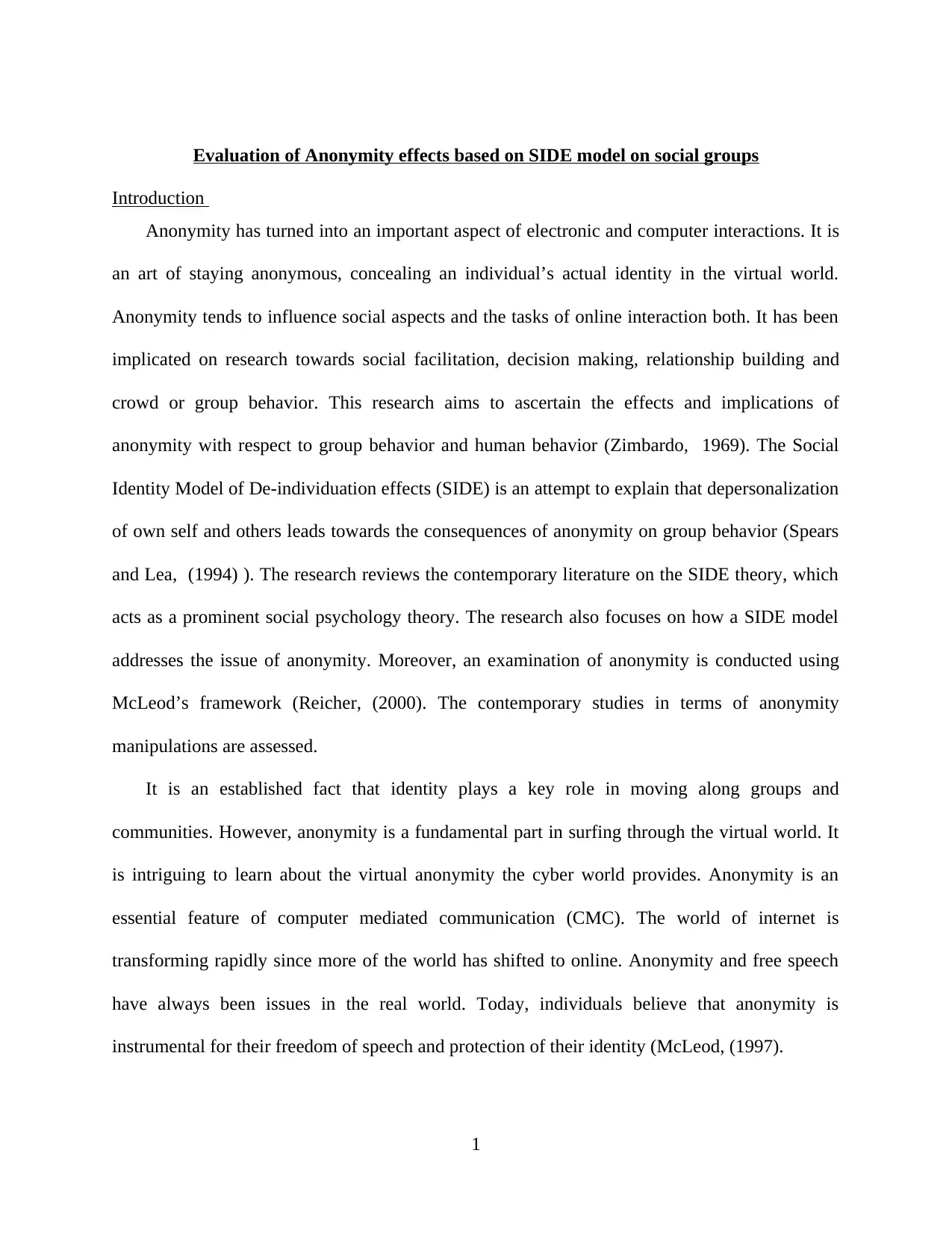
Evaluation of Anonymity effects based on SIDE model on social groups
Introduction
Anonymity has turned into an important aspect of electronic and computer interactions. It is
an art of staying anonymous, concealing an individual’s actual identity in the virtual world.
Anonymity tends to influence social aspects and the tasks of online interaction both. It has been
implicated on research towards social facilitation, decision making, relationship building and
crowd or group behavior. This research aims to ascertain the effects and implications of
anonymity with respect to group behavior and human behavior (Zimbardo, 1969). The Social
Identity Model of De-individuation effects (SIDE) is an attempt to explain that depersonalization
of own self and others leads towards the consequences of anonymity on group behavior (Spears
and Lea, (1994) ). The research reviews the contemporary literature on the SIDE theory, which
acts as a prominent social psychology theory. The research also focuses on how a SIDE model
addresses the issue of anonymity. Moreover, an examination of anonymity is conducted using
McLeod’s framework (Reicher, (2000). The contemporary studies in terms of anonymity
manipulations are assessed.
It is an established fact that identity plays a key role in moving along groups and
communities. However, anonymity is a fundamental part in surfing through the virtual world. It
is intriguing to learn about the virtual anonymity the cyber world provides. Anonymity is an
essential feature of computer mediated communication (CMC). The world of internet is
transforming rapidly since more of the world has shifted to online. Anonymity and free speech
have always been issues in the real world. Today, individuals believe that anonymity is
instrumental for their freedom of speech and protection of their identity (McLeod, (1997).
1
Introduction
Anonymity has turned into an important aspect of electronic and computer interactions. It is
an art of staying anonymous, concealing an individual’s actual identity in the virtual world.
Anonymity tends to influence social aspects and the tasks of online interaction both. It has been
implicated on research towards social facilitation, decision making, relationship building and
crowd or group behavior. This research aims to ascertain the effects and implications of
anonymity with respect to group behavior and human behavior (Zimbardo, 1969). The Social
Identity Model of De-individuation effects (SIDE) is an attempt to explain that depersonalization
of own self and others leads towards the consequences of anonymity on group behavior (Spears
and Lea, (1994) ). The research reviews the contemporary literature on the SIDE theory, which
acts as a prominent social psychology theory. The research also focuses on how a SIDE model
addresses the issue of anonymity. Moreover, an examination of anonymity is conducted using
McLeod’s framework (Reicher, (2000). The contemporary studies in terms of anonymity
manipulations are assessed.
It is an established fact that identity plays a key role in moving along groups and
communities. However, anonymity is a fundamental part in surfing through the virtual world. It
is intriguing to learn about the virtual anonymity the cyber world provides. Anonymity is an
essential feature of computer mediated communication (CMC). The world of internet is
transforming rapidly since more of the world has shifted to online. Anonymity and free speech
have always been issues in the real world. Today, individuals believe that anonymity is
instrumental for their freedom of speech and protection of their identity (McLeod, (1997).
1
Paraphrase This Document
Need a fresh take? Get an instant paraphrase of this document with our AI Paraphraser
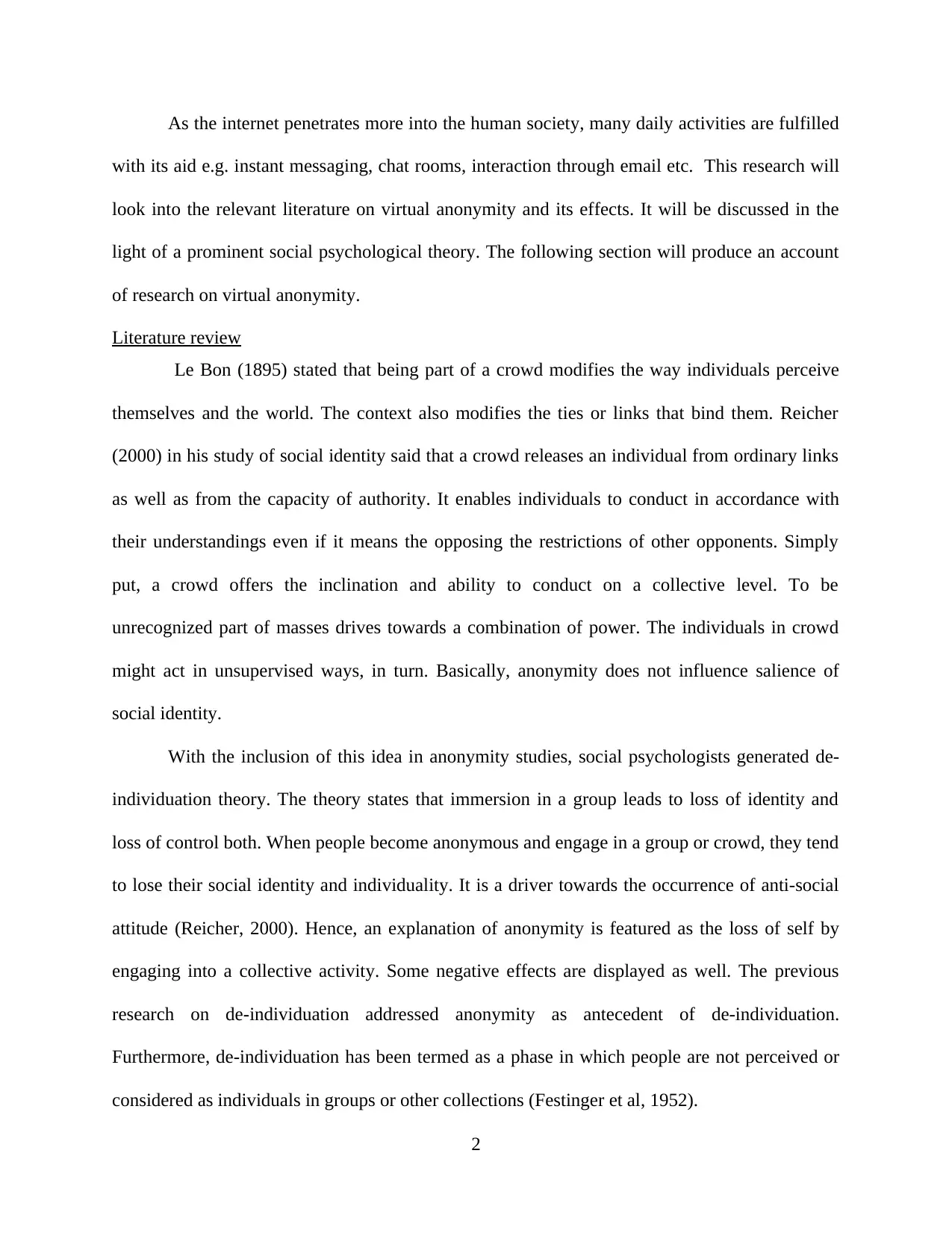
As the internet penetrates more into the human society, many daily activities are fulfilled
with its aid e.g. instant messaging, chat rooms, interaction through email etc. This research will
look into the relevant literature on virtual anonymity and its effects. It will be discussed in the
light of a prominent social psychological theory. The following section will produce an account
of research on virtual anonymity.
Literature review
Le Bon (1895) stated that being part of a crowd modifies the way individuals perceive
themselves and the world. The context also modifies the ties or links that bind them. Reicher
(2000) in his study of social identity said that a crowd releases an individual from ordinary links
as well as from the capacity of authority. It enables individuals to conduct in accordance with
their understandings even if it means the opposing the restrictions of other opponents. Simply
put, a crowd offers the inclination and ability to conduct on a collective level. To be
unrecognized part of masses drives towards a combination of power. The individuals in crowd
might act in unsupervised ways, in turn. Basically, anonymity does not influence salience of
social identity.
With the inclusion of this idea in anonymity studies, social psychologists generated de-
individuation theory. The theory states that immersion in a group leads to loss of identity and
loss of control both. When people become anonymous and engage in a group or crowd, they tend
to lose their social identity and individuality. It is a driver towards the occurrence of anti-social
attitude (Reicher, 2000). Hence, an explanation of anonymity is featured as the loss of self by
engaging into a collective activity. Some negative effects are displayed as well. The previous
research on de-individuation addressed anonymity as antecedent of de-individuation.
Furthermore, de-individuation has been termed as a phase in which people are not perceived or
considered as individuals in groups or other collections (Festinger et al, 1952).
2
with its aid e.g. instant messaging, chat rooms, interaction through email etc. This research will
look into the relevant literature on virtual anonymity and its effects. It will be discussed in the
light of a prominent social psychological theory. The following section will produce an account
of research on virtual anonymity.
Literature review
Le Bon (1895) stated that being part of a crowd modifies the way individuals perceive
themselves and the world. The context also modifies the ties or links that bind them. Reicher
(2000) in his study of social identity said that a crowd releases an individual from ordinary links
as well as from the capacity of authority. It enables individuals to conduct in accordance with
their understandings even if it means the opposing the restrictions of other opponents. Simply
put, a crowd offers the inclination and ability to conduct on a collective level. To be
unrecognized part of masses drives towards a combination of power. The individuals in crowd
might act in unsupervised ways, in turn. Basically, anonymity does not influence salience of
social identity.
With the inclusion of this idea in anonymity studies, social psychologists generated de-
individuation theory. The theory states that immersion in a group leads to loss of identity and
loss of control both. When people become anonymous and engage in a group or crowd, they tend
to lose their social identity and individuality. It is a driver towards the occurrence of anti-social
attitude (Reicher, 2000). Hence, an explanation of anonymity is featured as the loss of self by
engaging into a collective activity. Some negative effects are displayed as well. The previous
research on de-individuation addressed anonymity as antecedent of de-individuation.
Furthermore, de-individuation has been termed as a phase in which people are not perceived or
considered as individuals in groups or other collections (Festinger et al, 1952).
2
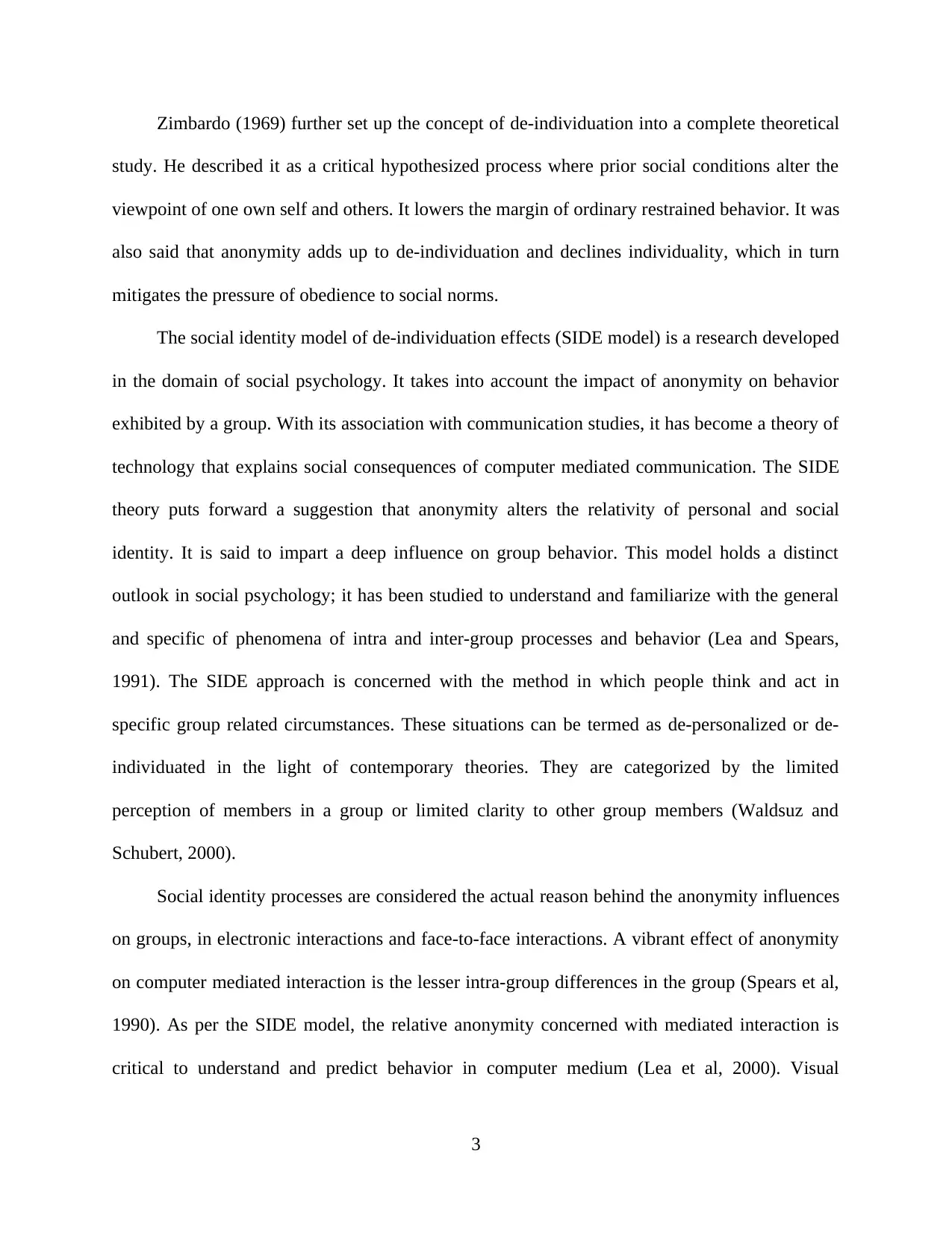
Zimbardo (1969) further set up the concept of de-individuation into a complete theoretical
study. He described it as a critical hypothesized process where prior social conditions alter the
viewpoint of one own self and others. It lowers the margin of ordinary restrained behavior. It was
also said that anonymity adds up to de-individuation and declines individuality, which in turn
mitigates the pressure of obedience to social norms.
The social identity model of de-individuation effects (SIDE model) is a research developed
in the domain of social psychology. It takes into account the impact of anonymity on behavior
exhibited by a group. With its association with communication studies, it has become a theory of
technology that explains social consequences of computer mediated communication. The SIDE
theory puts forward a suggestion that anonymity alters the relativity of personal and social
identity. It is said to impart a deep influence on group behavior. This model holds a distinct
outlook in social psychology; it has been studied to understand and familiarize with the general
and specific of phenomena of intra and inter-group processes and behavior (Lea and Spears,
1991). The SIDE approach is concerned with the method in which people think and act in
specific group related circumstances. These situations can be termed as de-personalized or de-
individuated in the light of contemporary theories. They are categorized by the limited
perception of members in a group or limited clarity to other group members (Waldsuz and
Schubert, 2000).
Social identity processes are considered the actual reason behind the anonymity influences
on groups, in electronic interactions and face-to-face interactions. A vibrant effect of anonymity
on computer mediated interaction is the lesser intra-group differences in the group (Spears et al,
1990). As per the SIDE model, the relative anonymity concerned with mediated interaction is
critical to understand and predict behavior in computer medium (Lea et al, 2000). Visual
3
study. He described it as a critical hypothesized process where prior social conditions alter the
viewpoint of one own self and others. It lowers the margin of ordinary restrained behavior. It was
also said that anonymity adds up to de-individuation and declines individuality, which in turn
mitigates the pressure of obedience to social norms.
The social identity model of de-individuation effects (SIDE model) is a research developed
in the domain of social psychology. It takes into account the impact of anonymity on behavior
exhibited by a group. With its association with communication studies, it has become a theory of
technology that explains social consequences of computer mediated communication. The SIDE
theory puts forward a suggestion that anonymity alters the relativity of personal and social
identity. It is said to impart a deep influence on group behavior. This model holds a distinct
outlook in social psychology; it has been studied to understand and familiarize with the general
and specific of phenomena of intra and inter-group processes and behavior (Lea and Spears,
1991). The SIDE approach is concerned with the method in which people think and act in
specific group related circumstances. These situations can be termed as de-personalized or de-
individuated in the light of contemporary theories. They are categorized by the limited
perception of members in a group or limited clarity to other group members (Waldsuz and
Schubert, 2000).
Social identity processes are considered the actual reason behind the anonymity influences
on groups, in electronic interactions and face-to-face interactions. A vibrant effect of anonymity
on computer mediated interaction is the lesser intra-group differences in the group (Spears et al,
1990). As per the SIDE model, the relative anonymity concerned with mediated interaction is
critical to understand and predict behavior in computer medium (Lea et al, 2000). Visual
3
⊘ This is a preview!⊘
Do you want full access?
Subscribe today to unlock all pages.

Trusted by 1+ million students worldwide
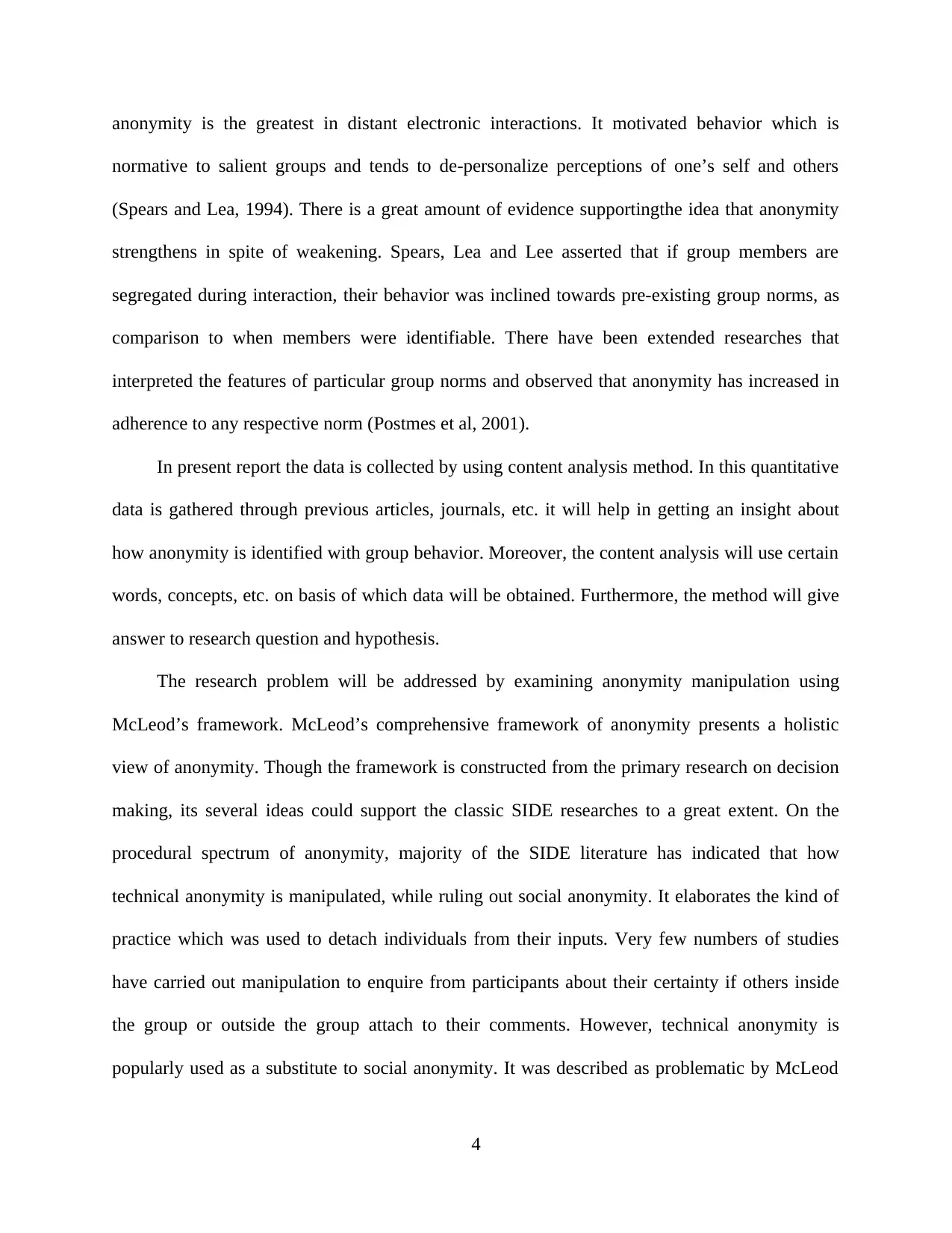
anonymity is the greatest in distant electronic interactions. It motivated behavior which is
normative to salient groups and tends to de-personalize perceptions of one’s self and others
(Spears and Lea, 1994). There is a great amount of evidence supportingthe idea that anonymity
strengthens in spite of weakening. Spears, Lea and Lee asserted that if group members are
segregated during interaction, their behavior was inclined towards pre-existing group norms, as
comparison to when members were identifiable. There have been extended researches that
interpreted the features of particular group norms and observed that anonymity has increased in
adherence to any respective norm (Postmes et al, 2001).
In present report the data is collected by using content analysis method. In this quantitative
data is gathered through previous articles, journals, etc. it will help in getting an insight about
how anonymity is identified with group behavior. Moreover, the content analysis will use certain
words, concepts, etc. on basis of which data will be obtained. Furthermore, the method will give
answer to research question and hypothesis.
The research problem will be addressed by examining anonymity manipulation using
McLeod’s framework. McLeod’s comprehensive framework of anonymity presents a holistic
view of anonymity. Though the framework is constructed from the primary research on decision
making, its several ideas could support the classic SIDE researches to a great extent. On the
procedural spectrum of anonymity, majority of the SIDE literature has indicated that how
technical anonymity is manipulated, while ruling out social anonymity. It elaborates the kind of
practice which was used to detach individuals from their inputs. Very few numbers of studies
have carried out manipulation to enquire from participants about their certainty if others inside
the group or outside the group attach to their comments. However, technical anonymity is
popularly used as a substitute to social anonymity. It was described as problematic by McLeod
4
normative to salient groups and tends to de-personalize perceptions of one’s self and others
(Spears and Lea, 1994). There is a great amount of evidence supportingthe idea that anonymity
strengthens in spite of weakening. Spears, Lea and Lee asserted that if group members are
segregated during interaction, their behavior was inclined towards pre-existing group norms, as
comparison to when members were identifiable. There have been extended researches that
interpreted the features of particular group norms and observed that anonymity has increased in
adherence to any respective norm (Postmes et al, 2001).
In present report the data is collected by using content analysis method. In this quantitative
data is gathered through previous articles, journals, etc. it will help in getting an insight about
how anonymity is identified with group behavior. Moreover, the content analysis will use certain
words, concepts, etc. on basis of which data will be obtained. Furthermore, the method will give
answer to research question and hypothesis.
The research problem will be addressed by examining anonymity manipulation using
McLeod’s framework. McLeod’s comprehensive framework of anonymity presents a holistic
view of anonymity. Though the framework is constructed from the primary research on decision
making, its several ideas could support the classic SIDE researches to a great extent. On the
procedural spectrum of anonymity, majority of the SIDE literature has indicated that how
technical anonymity is manipulated, while ruling out social anonymity. It elaborates the kind of
practice which was used to detach individuals from their inputs. Very few numbers of studies
have carried out manipulation to enquire from participants about their certainty if others inside
the group or outside the group attach to their comments. However, technical anonymity is
popularly used as a substitute to social anonymity. It was described as problematic by McLeod
4
Paraphrase This Document
Need a fresh take? Get an instant paraphrase of this document with our AI Paraphraser
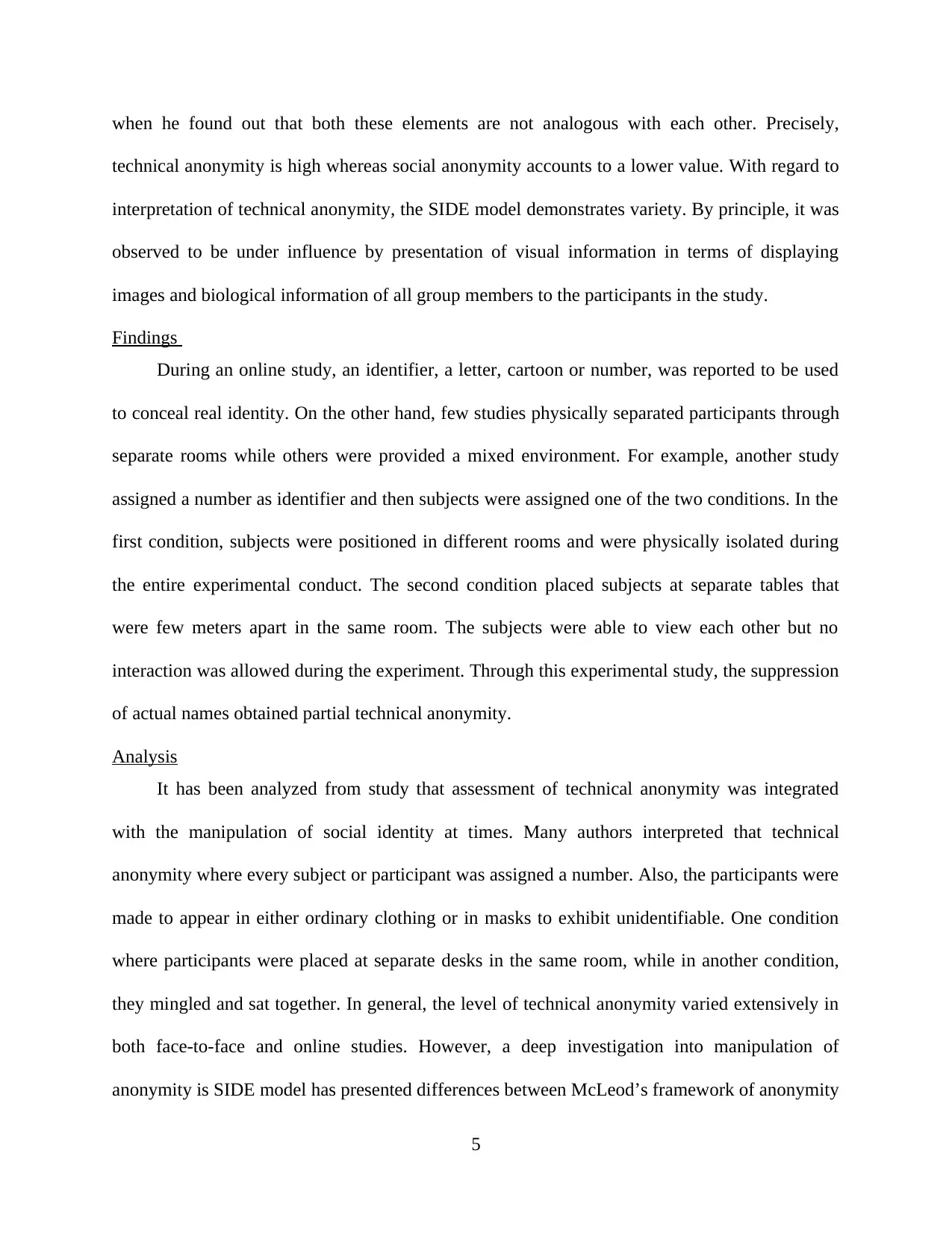
when he found out that both these elements are not analogous with each other. Precisely,
technical anonymity is high whereas social anonymity accounts to a lower value. With regard to
interpretation of technical anonymity, the SIDE model demonstrates variety. By principle, it was
observed to be under influence by presentation of visual information in terms of displaying
images and biological information of all group members to the participants in the study.
Findings
During an online study, an identifier, a letter, cartoon or number, was reported to be used
to conceal real identity. On the other hand, few studies physically separated participants through
separate rooms while others were provided a mixed environment. For example, another study
assigned a number as identifier and then subjects were assigned one of the two conditions. In the
first condition, subjects were positioned in different rooms and were physically isolated during
the entire experimental conduct. The second condition placed subjects at separate tables that
were few meters apart in the same room. The subjects were able to view each other but no
interaction was allowed during the experiment. Through this experimental study, the suppression
of actual names obtained partial technical anonymity.
Analysis
It has been analyzed from study that assessment of technical anonymity was integrated
with the manipulation of social identity at times. Many authors interpreted that technical
anonymity where every subject or participant was assigned a number. Also, the participants were
made to appear in either ordinary clothing or in masks to exhibit unidentifiable. One condition
where participants were placed at separate desks in the same room, while in another condition,
they mingled and sat together. In general, the level of technical anonymity varied extensively in
both face-to-face and online studies. However, a deep investigation into manipulation of
anonymity is SIDE model has presented differences between McLeod’s framework of anonymity
5
technical anonymity is high whereas social anonymity accounts to a lower value. With regard to
interpretation of technical anonymity, the SIDE model demonstrates variety. By principle, it was
observed to be under influence by presentation of visual information in terms of displaying
images and biological information of all group members to the participants in the study.
Findings
During an online study, an identifier, a letter, cartoon or number, was reported to be used
to conceal real identity. On the other hand, few studies physically separated participants through
separate rooms while others were provided a mixed environment. For example, another study
assigned a number as identifier and then subjects were assigned one of the two conditions. In the
first condition, subjects were positioned in different rooms and were physically isolated during
the entire experimental conduct. The second condition placed subjects at separate tables that
were few meters apart in the same room. The subjects were able to view each other but no
interaction was allowed during the experiment. Through this experimental study, the suppression
of actual names obtained partial technical anonymity.
Analysis
It has been analyzed from study that assessment of technical anonymity was integrated
with the manipulation of social identity at times. Many authors interpreted that technical
anonymity where every subject or participant was assigned a number. Also, the participants were
made to appear in either ordinary clothing or in masks to exhibit unidentifiable. One condition
where participants were placed at separate desks in the same room, while in another condition,
they mingled and sat together. In general, the level of technical anonymity varied extensively in
both face-to-face and online studies. However, a deep investigation into manipulation of
anonymity is SIDE model has presented differences between McLeod’s framework of anonymity
5
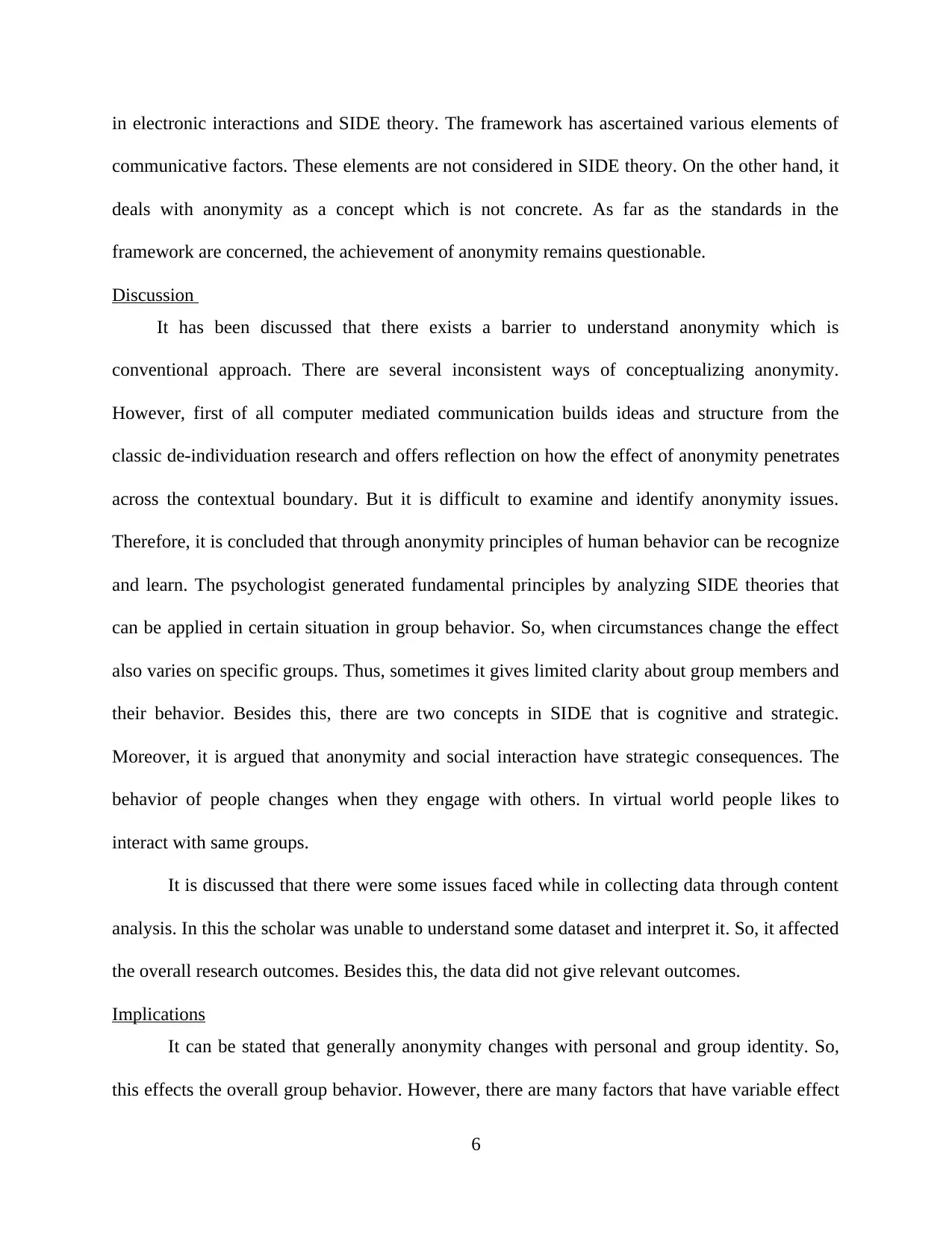
in electronic interactions and SIDE theory. The framework has ascertained various elements of
communicative factors. These elements are not considered in SIDE theory. On the other hand, it
deals with anonymity as a concept which is not concrete. As far as the standards in the
framework are concerned, the achievement of anonymity remains questionable.
Discussion
It has been discussed that there exists a barrier to understand anonymity which is
conventional approach. There are several inconsistent ways of conceptualizing anonymity.
However, first of all computer mediated communication builds ideas and structure from the
classic de-individuation research and offers reflection on how the effect of anonymity penetrates
across the contextual boundary. But it is difficult to examine and identify anonymity issues.
Therefore, it is concluded that through anonymity principles of human behavior can be recognize
and learn. The psychologist generated fundamental principles by analyzing SIDE theories that
can be applied in certain situation in group behavior. So, when circumstances change the effect
also varies on specific groups. Thus, sometimes it gives limited clarity about group members and
their behavior. Besides this, there are two concepts in SIDE that is cognitive and strategic.
Moreover, it is argued that anonymity and social interaction have strategic consequences. The
behavior of people changes when they engage with others. In virtual world people likes to
interact with same groups.
It is discussed that there were some issues faced while in collecting data through content
analysis. In this the scholar was unable to understand some dataset and interpret it. So, it affected
the overall research outcomes. Besides this, the data did not give relevant outcomes.
Implications
It can be stated that generally anonymity changes with personal and group identity. So,
this effects the overall group behavior. However, there are many factors that have variable effect
6
communicative factors. These elements are not considered in SIDE theory. On the other hand, it
deals with anonymity as a concept which is not concrete. As far as the standards in the
framework are concerned, the achievement of anonymity remains questionable.
Discussion
It has been discussed that there exists a barrier to understand anonymity which is
conventional approach. There are several inconsistent ways of conceptualizing anonymity.
However, first of all computer mediated communication builds ideas and structure from the
classic de-individuation research and offers reflection on how the effect of anonymity penetrates
across the contextual boundary. But it is difficult to examine and identify anonymity issues.
Therefore, it is concluded that through anonymity principles of human behavior can be recognize
and learn. The psychologist generated fundamental principles by analyzing SIDE theories that
can be applied in certain situation in group behavior. So, when circumstances change the effect
also varies on specific groups. Thus, sometimes it gives limited clarity about group members and
their behavior. Besides this, there are two concepts in SIDE that is cognitive and strategic.
Moreover, it is argued that anonymity and social interaction have strategic consequences. The
behavior of people changes when they engage with others. In virtual world people likes to
interact with same groups.
It is discussed that there were some issues faced while in collecting data through content
analysis. In this the scholar was unable to understand some dataset and interpret it. So, it affected
the overall research outcomes. Besides this, the data did not give relevant outcomes.
Implications
It can be stated that generally anonymity changes with personal and group identity. So,
this effects the overall group behavior. However, there are many factors that have variable effect
6
⊘ This is a preview!⊘
Do you want full access?
Subscribe today to unlock all pages.

Trusted by 1+ million students worldwide

on behavior. Also, the behavior of individual is changed when they meet new groups. They act
according to situation. It is necessary to understand people behavior so that effect of anonymity
can be understood.
7
according to situation. It is necessary to understand people behavior so that effect of anonymity
can be understood.
7
Paraphrase This Document
Need a fresh take? Get an instant paraphrase of this document with our AI Paraphraser
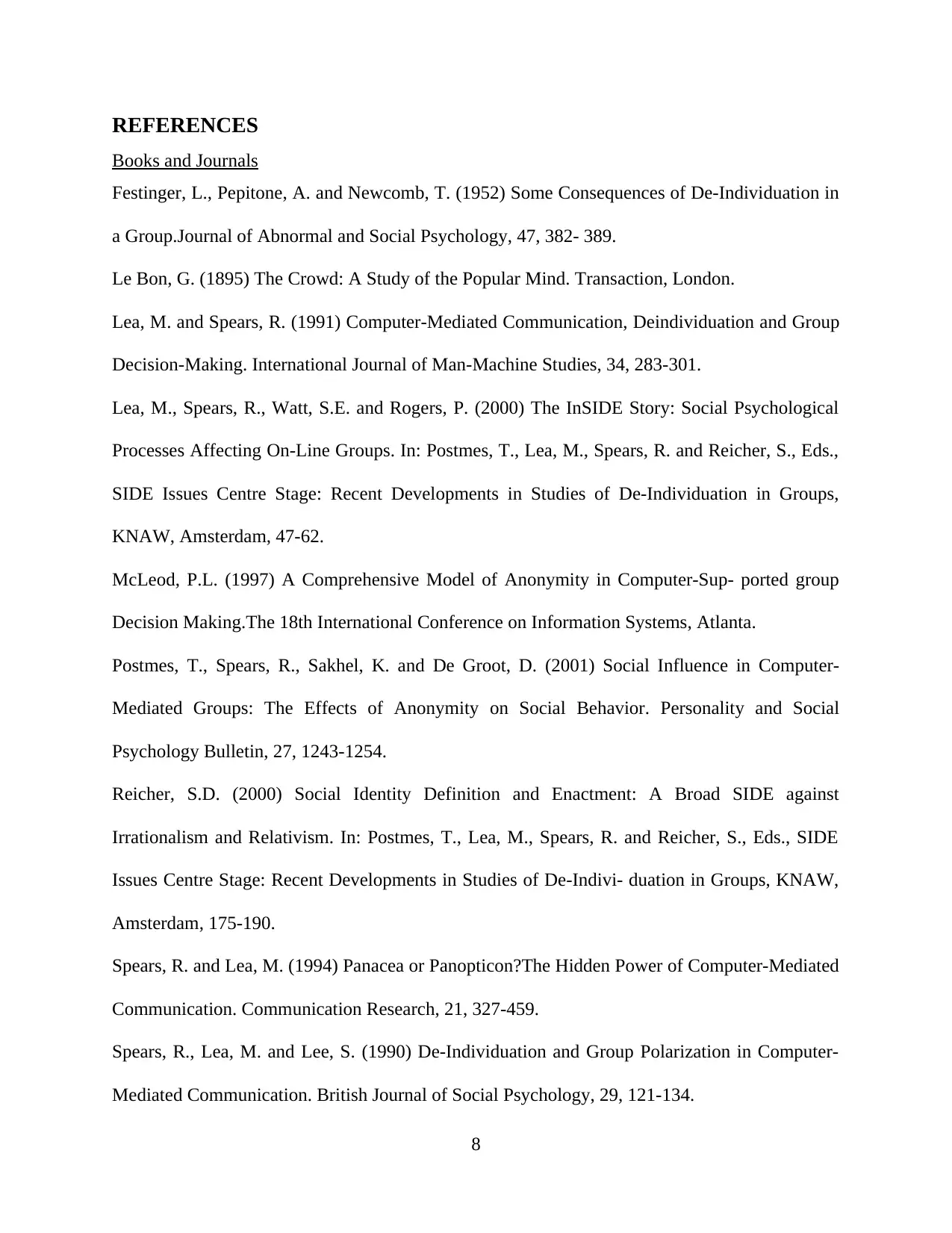
REFERENCES
Books and Journals
Festinger, L., Pepitone, A. and Newcomb, T. (1952) Some Consequences of De-Individuation in
a Group.Journal of Abnormal and Social Psychology, 47, 382- 389.
Le Bon, G. (1895) The Crowd: A Study of the Popular Mind. Transaction, London.
Lea, M. and Spears, R. (1991) Computer-Mediated Communication, Deindividuation and Group
Decision-Making. International Journal of Man-Machine Studies, 34, 283-301.
Lea, M., Spears, R., Watt, S.E. and Rogers, P. (2000) The InSIDE Story: Social Psychological
Processes Affecting On-Line Groups. In: Postmes, T., Lea, M., Spears, R. and Reicher, S., Eds.,
SIDE Issues Centre Stage: Recent Developments in Studies of De-Individuation in Groups,
KNAW, Amsterdam, 47-62.
McLeod, P.L. (1997) A Comprehensive Model of Anonymity in Computer-Sup- ported group
Decision Making.The 18th International Conference on Information Systems, Atlanta.
Postmes, T., Spears, R., Sakhel, K. and De Groot, D. (2001) Social Influence in Computer-
Mediated Groups: The Effects of Anonymity on Social Behavior. Personality and Social
Psychology Bulletin, 27, 1243-1254.
Reicher, S.D. (2000) Social Identity Definition and Enactment: A Broad SIDE against
Irrationalism and Relativism. In: Postmes, T., Lea, M., Spears, R. and Reicher, S., Eds., SIDE
Issues Centre Stage: Recent Developments in Studies of De-Indivi- duation in Groups, KNAW,
Amsterdam, 175-190.
Spears, R. and Lea, M. (1994) Panacea or Panopticon?The Hidden Power of Computer-Mediated
Communication. Communication Research, 21, 327-459.
Spears, R., Lea, M. and Lee, S. (1990) De-Individuation and Group Polarization in Computer-
Mediated Communication. British Journal of Social Psychology, 29, 121-134.
8
Books and Journals
Festinger, L., Pepitone, A. and Newcomb, T. (1952) Some Consequences of De-Individuation in
a Group.Journal of Abnormal and Social Psychology, 47, 382- 389.
Le Bon, G. (1895) The Crowd: A Study of the Popular Mind. Transaction, London.
Lea, M. and Spears, R. (1991) Computer-Mediated Communication, Deindividuation and Group
Decision-Making. International Journal of Man-Machine Studies, 34, 283-301.
Lea, M., Spears, R., Watt, S.E. and Rogers, P. (2000) The InSIDE Story: Social Psychological
Processes Affecting On-Line Groups. In: Postmes, T., Lea, M., Spears, R. and Reicher, S., Eds.,
SIDE Issues Centre Stage: Recent Developments in Studies of De-Individuation in Groups,
KNAW, Amsterdam, 47-62.
McLeod, P.L. (1997) A Comprehensive Model of Anonymity in Computer-Sup- ported group
Decision Making.The 18th International Conference on Information Systems, Atlanta.
Postmes, T., Spears, R., Sakhel, K. and De Groot, D. (2001) Social Influence in Computer-
Mediated Groups: The Effects of Anonymity on Social Behavior. Personality and Social
Psychology Bulletin, 27, 1243-1254.
Reicher, S.D. (2000) Social Identity Definition and Enactment: A Broad SIDE against
Irrationalism and Relativism. In: Postmes, T., Lea, M., Spears, R. and Reicher, S., Eds., SIDE
Issues Centre Stage: Recent Developments in Studies of De-Indivi- duation in Groups, KNAW,
Amsterdam, 175-190.
Spears, R. and Lea, M. (1994) Panacea or Panopticon?The Hidden Power of Computer-Mediated
Communication. Communication Research, 21, 327-459.
Spears, R., Lea, M. and Lee, S. (1990) De-Individuation and Group Polarization in Computer-
Mediated Communication. British Journal of Social Psychology, 29, 121-134.
8
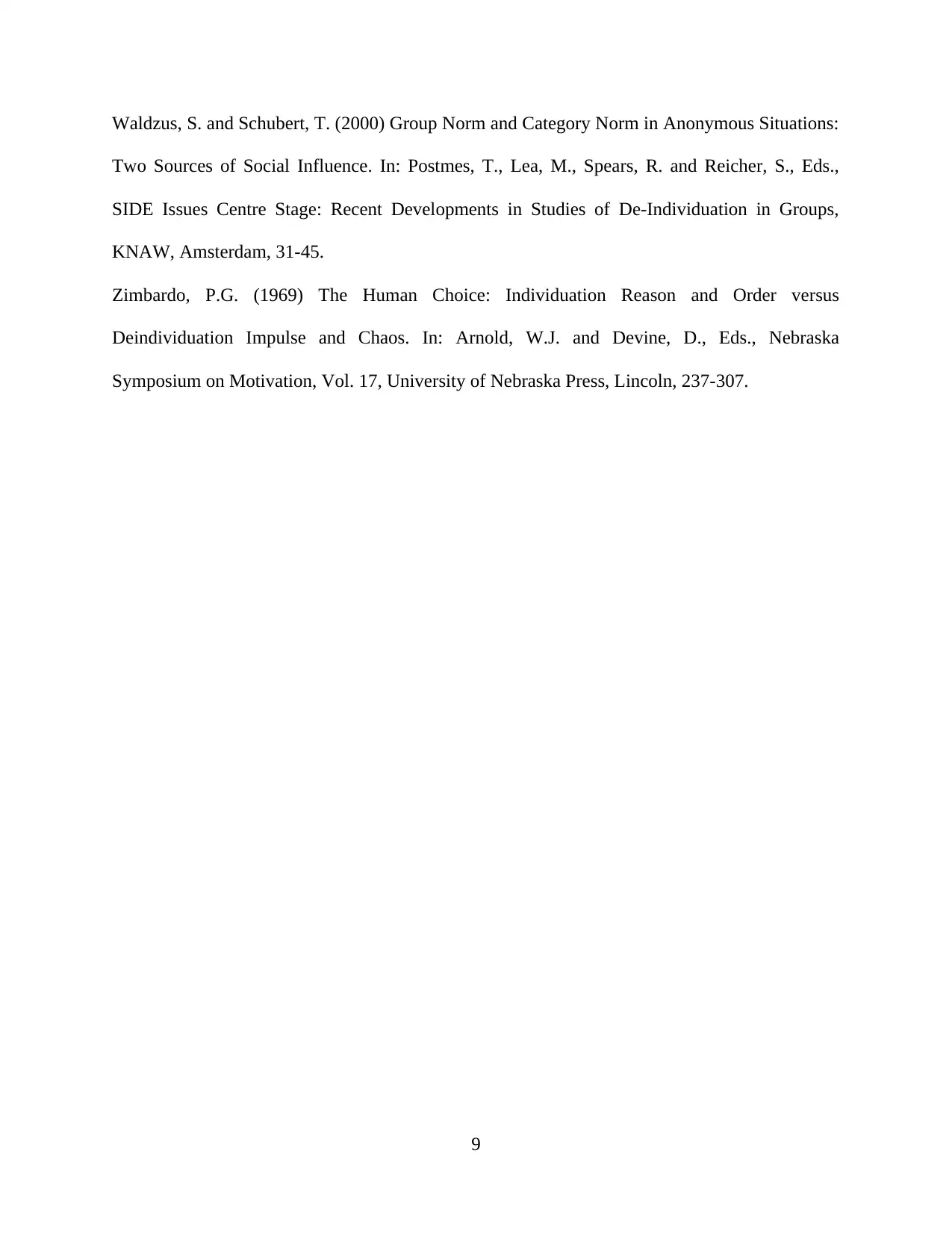
Waldzus, S. and Schubert, T. (2000) Group Norm and Category Norm in Anonymous Situations:
Two Sources of Social Influence. In: Postmes, T., Lea, M., Spears, R. and Reicher, S., Eds.,
SIDE Issues Centre Stage: Recent Developments in Studies of De-Individuation in Groups,
KNAW, Amsterdam, 31-45.
Zimbardo, P.G. (1969) The Human Choice: Individuation Reason and Order versus
Deindividuation Impulse and Chaos. In: Arnold, W.J. and Devine, D., Eds., Nebraska
Symposium on Motivation, Vol. 17, University of Nebraska Press, Lincoln, 237-307.
9
Two Sources of Social Influence. In: Postmes, T., Lea, M., Spears, R. and Reicher, S., Eds.,
SIDE Issues Centre Stage: Recent Developments in Studies of De-Individuation in Groups,
KNAW, Amsterdam, 31-45.
Zimbardo, P.G. (1969) The Human Choice: Individuation Reason and Order versus
Deindividuation Impulse and Chaos. In: Arnold, W.J. and Devine, D., Eds., Nebraska
Symposium on Motivation, Vol. 17, University of Nebraska Press, Lincoln, 237-307.
9
⊘ This is a preview!⊘
Do you want full access?
Subscribe today to unlock all pages.

Trusted by 1+ million students worldwide
1 out of 12
Related Documents
Your All-in-One AI-Powered Toolkit for Academic Success.
+13062052269
info@desklib.com
Available 24*7 on WhatsApp / Email
![[object Object]](/_next/static/media/star-bottom.7253800d.svg)
Unlock your academic potential
Copyright © 2020–2025 A2Z Services. All Rights Reserved. Developed and managed by ZUCOL.





